- Wagner Graduate School of Public Service, New York University, New York City, NY, United States
Nitrogen dioxide (NO2) is a pollutant of concern in urban areas around the world. The main sources in urban environments are related to the burning of fuel and include transportation, electricity generation, and industrial and residential activities. From a public health perspective NO2 has also been widely associated with respiratory disease, including asthma exacerbation. NO2 also plays a key role in ground-level concentrations of ozone (O3), which is also a public health concern. This policy brief explores the relationships between transportation, climate change mitigation and ambient levels of air pollutants such as NO2. The Covid-19 pandemic has offered a glimpse of how rapid changes in transportation use can result in significant decreases in NO2 concentrations. Data from New York City supports this relationship. Transportation policies aimed at reducing traffic offer an opportunity to both mitigate greenhouse gas emissions and improve air quality. The implementation of measures to rethink public space and the use of streets in response to Covid-19 also provides insights into an additional policy alternative to achieve these goals.
Ambient Concentrations of Nitrogen Dioxide
Nitrogen dioxide (NO2) is a pollutant of concern in urban areas around the world. The main sources of NO2 are related to transportation and stationary fuel combustion sources [U.S Environmental Protection Agency (EPA), 2018]. In New York City, the highest concentrations of NO2 are estimated to be in areas with high traffic, high density of buildings that burn fuel for heating and to run water boilers, and industrial land uses (New York City Department of Health and Mental Hygiene, 2020). In the United States, the implementation of fuel efficiency and vehicle pollution emissions regulations have resulted in a decrease in ambient concentrations of NO2 in the last few decades [U.S. Environmental Protection Agency (EPA), 2018]. In New York City, concentrations of NO2 declined by 29% between 2009 and 2018. These concentration values are derived from monitoring stations (New York City Department of Health and Mental Hygiene, 2020).
Characterizing concentrations of NO2 in a city can be difficult because NO2 concentrations can vary significantly depending on traffic concentrations. There is also evidence that the height of monitoring stations is important in measuring this pollutant. A study in the South Bronx, New York City, found significant differences in concentrations at 4 and 15 m above ground-level (Restrepo et al., 2004). More recently, satellite measurements have started to provide estimates of concentrations of NO2 at ground level across wide geographical areas, including places where there are no monitoring stations. At the global scale, NO2 concentrations are decreasing in North America and Europe, but seem to be increasing in East Asia (Geddes et al., 2016). These differences are related to urban growth, the implementation of transportation and energy policies that impact the amount of fossil fuel combustion and emissions, and the demand for transportation and energy services.
The health effects of NO2 are well established [U.S. Environmental Protection Agency (EPA), 2016]. Both short-and long-term exposure to NO2 is associated with respiratory problems and asthma exacerbation [U.S. Environmental Protection Agency (EPA), 2018]. The U.S. EPA has set an annual standard (53 ppb) and an hourly standard (100 ppb) for this pollutant [U.S. Environmental Protection Agency (EPA), 2018]. These standards are meant to be protective of the general population but health impacts can occur below these concentrations. A study conducted in New York City for the period 1996–2000 found statistically significant associations between asthma hospital admissions and ambient concentrations of NO2 (Restrepo et al., 2012). A change in the inter-quartile range (IQR) of same day 24 h average NO2 concentrations had a positive association with asthma hospitalizations for children aged 0–17 years (IQR = 0.011 ppm, RR = 1.017, 95% CI = 1.001, 1.034). These associations were observed for concentrations below the annual standard (Restrepo et al., 2012).
Covid-19 and Its Impact on Transportation and Nitrogen Dioxide Concentrations
The Covid-19 pandemic has impacted every facet of life in cities around the world. In New York City, for example, the spread of the virus resulted in significant restrictions. On March 16, 2020 public schools in the city were closed (Shapiro, 2020). And starting on March 22, 2020, all non-essential businesses in New York State were closed (New York State Government, 2020). This had a dramatic impact on transportation activities in the region, including vehicular traffic. One proxy for traffic in New York City is the number of inbound and outbound vehicles on the seven bridges and two tunnels operated by the Metropolitan Transportation Authority (MTA). These facilities handle over 310 million vehicles per year [Metropolitan Transportation Authority (MTA), 2020a]. Figure 1 shows the average daily vehicular traffic on these bridges and tunnels operated by the MTA for the first 5 months of the year. Although not a perfect characterization of all traffic, these MTA figures provide a good description of traffic moving through New York City. The impact of the Covid-19 restrictions are clear, the average daily vehicular traffic for these MTA facilities decreased from approximately 749,761 in February to 537,147 in March and to 280,324 in April. Traffic at these facilities seems to have started increasing again in May, when this value was 419,464.
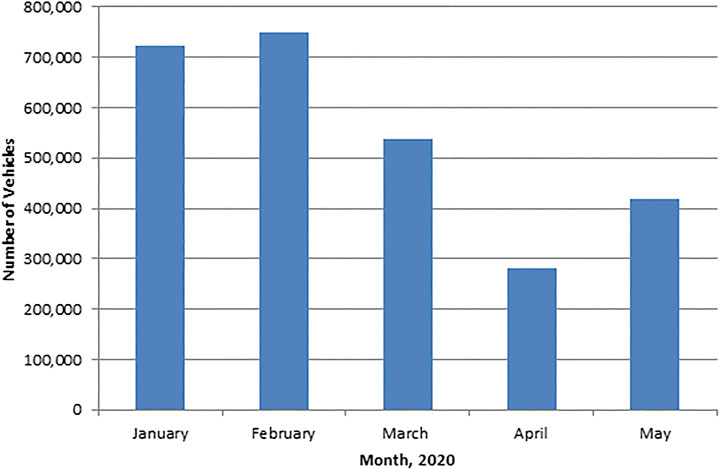
FIGURE 1. Average daily vehicular traffic on bridges and tunnels operated by the Metropolitan Transportation Authority (MTA) in New York. Source: Constructed using publicly available data from the Metropolitan Transportation Authority [Metropolitan Transportation Authority (MTA), 2020b].
Not surprisingly, during this period, average concentrations of NO2 measured by the New York State Department of Environmental Conservation (NYSDEC) through their network of monitoring stations also decreased significantly. DEC monitors hourly concentrations of NO2 at three monitoring stations in New York City and these data are publicly available. One is located in Bronx County and two are located in Queens County [New York State Department of Environmental Conservation (NYSDEC), 2020a]. Figure 2 shows the daily ambient concentration of NO2 estimated by averaging hourly concentrations over 24 h and averaging all available data for the three stations. These values are a proxy for ambient concentrations of NO2 in New York City for the period January 1-May 31, 2020. The figure shows that although there is significant daily variation, there is a downward trend in the last 3 months. Figure 3 shows the average daily concentration of NO2 from these three stations, estimated from the hourly measurements for the first 5 months of the year, and compares 2020 values to those of 2018 and 2019. Starting in March, the figures for 2020 are significantly lower than those of the two previous years. These two figures suggest that the impact of Covid-19 restrictions on transportation during this period has been very significant in terms of reducing ambient concentrations of NO2.
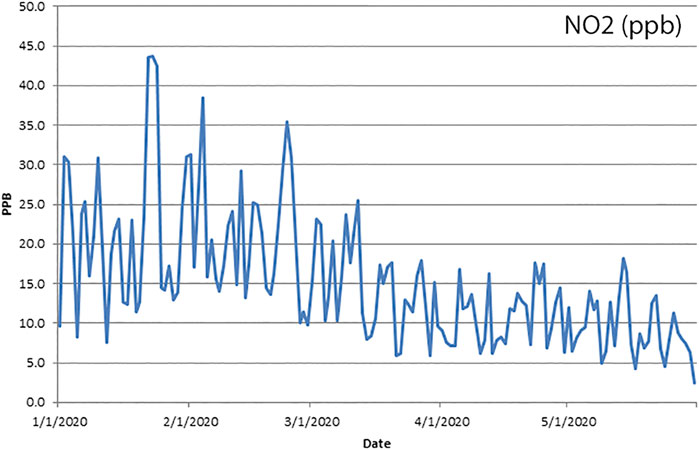
FIGURE 2. Daily concentrations of NO2 in New York City, January 1—May 31, 2020 (parts per billion). Source: Constructed using publicly available data from New York State Department of Environmental Conservation [New York State Department of Environmental Conservation (NYSDEC), 2020b].
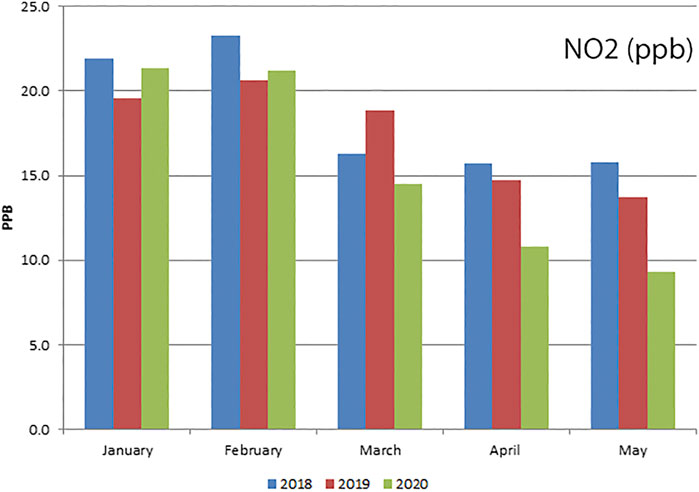
FIGURE 3. Average Daily Concentrations of NO2 in New York City, January 1—May 31, 2020 (parts per billion). Source: Constructed using publicly available data from New York State Department of Environmental Conservation (NYSDEC, 2020b).
Changes in the ambient concentration of NO2 cannot be attributed only to changes in traffic and industrial activity. Weather can also impact how NO2 disperses in an urban environment (Collivignarelli et al., 2021; Wong et al., 2021). Weather data recorded by a station in Central Park, New York City, and maintained by the National Centers for Environmental Information,1 indicates that the average maximum daily temperature there for March 2020 was 55°F. The corresponding figures for 2019 and 2018 were 49and 46°F. There was also some variation in precipitation. In March 2020, the total precipitation was 3.78 inches. The corresponding figures for 2019 and 2018 were 3.87 and 5.17 inches. Other meteorological factors, such as wind, can also influence NO2 concentrations. But in this case the significant drop observed is more likely caused by the changes in traffic.
Reductions in ambient concentrations of NO2 were also observed when lockdowns were mandated in cities around the world as a response to the Covid-19 pandemic. For example, in London, Milan and Paris, the observed reductions in NO2 concentrations during lockdown in 2020 compared to the same period for the years 2017–2019 were reported as 71.1–80.8%, 8.6–42.4%, and 65.7–79.8%, respectively (Collivignarelli et al., 2021). Similarly, concentrations of NO2 in Madrid and Barcelona during lockdown (March 2020), were 56 and 59% lower respectively, compared to March 2019 (Baldasano, 2021). A study that compared air pollution concentrations in 41 cities in India during the first lockdown (March 25–May 3, 2020) to concentrations during the same period in 2019 found that in New Delhi, Mumbai and Bangalore, the ambient NO2 concentrations were lower by 61.74, 43.08 and 48.25% respectively (Vadrevu et al., 2020).
Climate Change and Transportation
Climate change is a threat to human and natural systems (IPCC, 2018). Transportation is a significant source of greenhouse gas emissions and transportation policies can play a key role in climate change mitigation efforts. In the United States, transportation was responsible for about 28% of greenhouse gas emissions in 2018, making it the largest contributor [U.S. Environmental Protection Agency (EPA), 2020]. Within transportation, light-duty vehicles and medium- and heavy-duty trucks accounted for 82% of the sector’s greenhouse gas emissions in the same year [U.S. Environmental Protection Agency (EPA), 2020].
A recent report by the Intergovernmental Panel on Climate Change (2018, chapter 2) suggests that emissions scenarios consistent with an average global temperature increase of 1.5°C, which could avert severe impacts associated with higher temperature increases, could be achieved with significant energy reductions by the transportation sector, as part of a wider strategy involving other sectors. The IPCC recommends a decrease in energy use by the transportation sector of approximately 15% in 2050 compared to the levels recorded in 2015.
The figures presented in the previous section suggest that traffic on MTA bridges and tunnels in New York City experienced a decrease of more than 60% between February and April of 2020 as a result of policies aimed at curbing the spread of Covid-19. These traffic figures are likely to increase as the economy recovers in the aftermath of the pandemic. Satellite observations indicate that NO2 concentrations in some parts of the world are already reaching pre-pandemic levels (European Space Agency, 2021). But the current crisis has also provided urban areas with an opportunity to pause and think about the role of transportation, its impact on urban environments and additional policies that could reduce vehicle emissions of greenhouse gases and other air pollutants such as NO2. The relationship between climate change and ambient concentrations of NO2 will depend on the ways that climate change influences the demand for services that may change the amount of fossil fuels burned. For instance, increasing temperatures could create greater demand for air conditioning. If this demand is met through the use of increased fossil fuel consumption it could lead to greater emissions of NO2 from stationary sources. However, most climate change mitigation strategies call for shifting to renewable sources of energy which could also result in decreased NO2 concentrations. There are strong synergies between efforts to improve air quality and address climate change.
Changing Street Space to Accommodate Uses Other Than Vehicles and Transportation
As a response to Covid-19 and the need for social distancing, cities like New York have started to rethink the use of street space. Figures 4, 5 show a key urban activity in New York City that has adapted to pandemic conditions. As indoor dining was prohibited due to the risks of Covid-19 contagion, city authorities responded by allowing outdoor dining experiences that take advantage of sidewalk and street spaces. The city also responded by closing some streets to traffic to allow for these kinds of dining services and other uses consistent with social distancing and public health concerns related to Covid-19 [New York City Department of Transportation (NYCDOT), 2020]. Figure 4 shows a restaurant that has outdoor tables on the sidewalk and on space normally used for vehicle parking in the West Village in Manhattan. Temporary green barriers have been used to separate restaurant patrons from car traffic and noise. Figure 5 shows a street in the East Village in Manhattan that has been closed to traffic and is instead being used for outdoor dining and to provide more space for pedestrians.
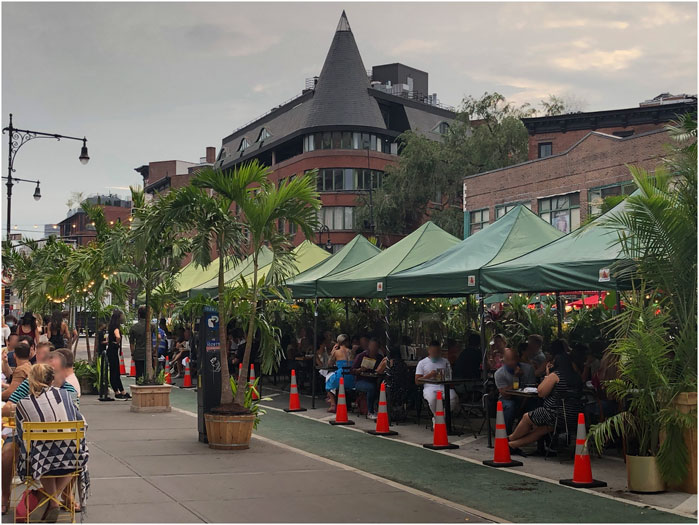
FIGURE 4. Modified street space to accommodate outdoor dining in the West Village neighborhood of Manhattan, New York City (August, 2020). Photo credit: Carlos E. Restrepo.
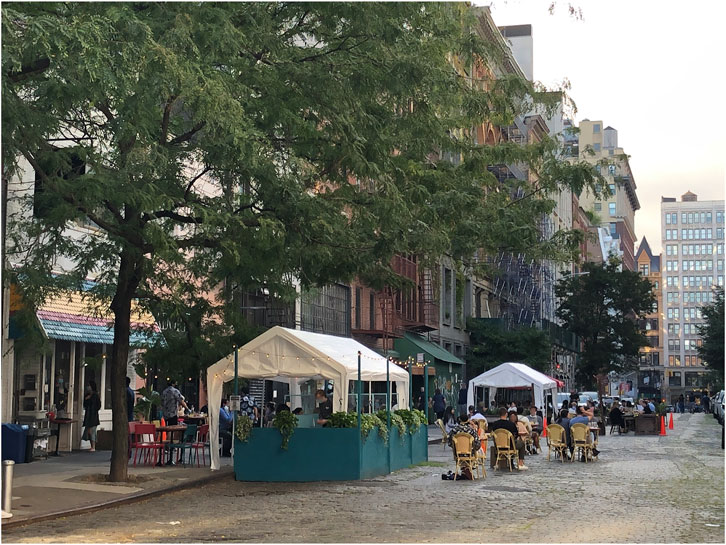
FIGURE 5. A street closure to accommodate outdoor dining and social distancing in the East Village neighborhood of Manhattan, New York City (September, 2020). Photo credit: Carlos E. Restrepo.
Similar measures have been widely adopted in cities around the world (Bellon, 2020). The success of these measures means they could be permanently adopted even after the pandemic. As urban residents and city authorities think about post-Covid-19 streetscapes, they should rethink the amount of space that should be accorded to private vehicles relative to other uses that favor pedestrians, bicycle users and public space for leisure. Doing so could provide cities with an additional policy option to improve air quality and public health and achieve greenhouse gas mitigation strategies.
Changing the use of street space to accommodate uses other than vehicular traffic should be accompanied by traffic management policies that reduce traffic. Otherwise simply closing streets or reducing the space available for vehicles could result in increased traffic congestion. Cities now have a range of proven measures that can be used to achieve this. Congestion pricing leverages the use of smart sensor technologies to charge a fee for using a vehicle during peak hours. This policy has been used successfully in Singapore, London, Oslo and other cities (Eliasson 2018) and has been shown to have a positive impact in terms of reducing traffic and air pollution, and improving public health (Simeonova et al., 2018). It has also been evaluated for New York City (Baghestani et al., 2020).
A number of public transit options, in addition to rail and metro systems, can also be used to reduce automobile dependence (Newman et al., 2017). Bus Rapid Transit (BRT) systems have also been used successfully in cities around the world to provide an alternative to the private automobile. They tend to be cheaper than subway systems and can adapt to existing road infrastructure (Wright 2001). Streetcars are increasingly being built and expanded in many cities (Wood and Brown, 2019). Non-motorized forms of transportation, like walking and bicycling, are also being encouraged by providing safe spaces and added infrastructure such as bicycle lanes and bike share systems (Pucher and Buehler, 2008; Nair et al., 2013; Hamilton and Wichman, 2018).
Covid-19 has also resulted in a decrease in the demand for public transit systems as users were afraid of being in close proximity to others. This was observed in New York City (Office of the New York State Comptroller, 2021). The result of reduced transit ridership had resulted in a significant loss of revenue that has threatened the operation of these systems (Tirachini and Cats, 2020). Supporting public transit systems as cities recover from Covid-19 will be critical to achieving improvements in air quality, reducing greenhouse gas emissions and supporting alternatives to private vehicles that allow for alternative uses of street space.
Additional support for programs aimed at allocating more space on streets for uses other than vehicular traffic could be secured if cities began to monitor air quality at these locations and evaluate their potential for air quality improvements. In the case of New York City, the network of air quality monitoring stations maintained by the New York State Department of Environmental Conservation is not designed to monitor air quality with high spatial resolution [New York State Department of Environmental Conservation (NYSDEC), 2020a]. There are too few stations and their goal is to monitor compliance with federal air quality standards at the city level. New York City Department of Health and Mental Hygiene (2020) has a network of monitoring stations that can measure and estimate air pollution concentrations with greater spatial resolution. Additional monitoring stations could be added to specifically assess the impact of programs such as Open Streets, which has resulted in the closure of some street to vehicular traffic in order to provide more space to pedestrians to follow social distancing guidelines and to allow activities like outdoor dining [New York City Department of Transportation (NYCDOT), 2020].
The impact of programs such as Open Streets on air quality could also be evaluated using low-cost air quality monitors. Although there are still some challenges with respect to the accuracy of these devices compared to the much more expensive traditional air quality monitors used to assess compliance with standards, their performance is improving rapidly and they are now recognized as being capable of providing good results to assess relative changes in air quality (Kumar et al., 2015; Jiao et al., 2016; Castell et al., 2017). In New York City, low-cost portable air monitors have been used to assess differences in the concentration of particulate matter (PM2.5) across neighborhoods and to identify air pollution hotspots (New York City Environmental Justice Alliance, 2021). There are now low-cost monitors that assess concentrations of other pollutants related to vehicular traffic, such as NO2 and carbon monoxide (CO). City authorities could engage communities through collaborative efforts to monitor air quality to assess the benefits of these programs and, if they are found to be meaningful, to gain their support for maintaining them.
Conclusion
There are a number of policies that can reduce the amount of fossil fuels burned by the transportation sector. These policies are consistent with the goals of climate change mitigation, improved air quality and healthier communities. The Covid-19 pandemic has resulted in some new ways of prioritizing street space in cities that could further reduce vehicle traffic if extended beyond the pandemic. On the other hand, the pandemic has also had a negative impact on the finances of public transit systems as ridership declined due to fears of contagion. Public transit is critical to achieving the greenhouse gas emissions reductions in urban areas consistent with keeping global temperature increases at 1.5°C or less. Public transit is also a key component of efforts to reduce air pollution. Cities should maintain and strengthen these systems beyond the pandemic. Additional well tested policies aimed at improving fuel efficiency, switching to less polluting fuels, adopting electric vehicles and promoting non-motorized forms of transportation should continue to be implemented as part of growing efforts to address climate change and improve air quality.
As cities begin to reopen economic activity they should not rush to reverse the measures taken to restrict traffic and repurpose street spaces. Instead, they should carefully monitor and evaluate the impact of such measures on air quality and their potential for greenhouse gas emissions mitigation. These policies could help cities achieve multiple goals related to environmental and social sustainability.
Author Contributions
The author confirms being the sole contributor of this work and has approved it for publication.
Conflict of Interest
The author declares that the research was conducted in the absence of any commercial or financial relationships that could be construed as a potential conflict of interest.
The handling editor declared a shared affiliation with the author CER at time of review.
Footnotes
1The weather data for Central Park, New York City were obtained from the National Oceanic and Atmospheric Administration’s National Centers for Environmental Information. The data are publicly available and can be accessed at: https://www.ncdc.noaa.gov/cdo-web/datasets/GHCND/stations/GHCND:USW00094728/detail (access date: May 12, 2021).
References
Baghestani, A., Tayarani, M., Allahviranloo, M., and Gao, H. O. (2020). Evaluating the Traffic and Emissions Impacts of Congestion Pricing in New York City. Sustainability 12 (9), 3655. doi:10.3390/su12093655
Baldasano, J. M. (2020). COVID-19 Lockdown Effects on Air Quality by NO2 in the Cities of Barcelona and Madrid (Spain). Sci. Total Environ. 741, 140353. doi:10.1016/j.scitotenv.2020.140353
Bellon, T. (2020). “New York City Will Close Some Streets to Cars, Expand Sidewalks during Coronavirus: Mayor,” Reuters. Available at: https://www.reuters.com/article/us-health-coronavirus-nyc-streets/new-york-city-will-close-some-streets-to-cars-expand-sidewalks-during-coronavirus-mayor-idUSKCN22923U (Access date August 31, 2020).
Castell, N., Dauge, F. R., Schneider, P., Vogt, M., Lerner, U., Fishbain, B., et al. (2017). Can Commercial Low-Cost Sensor Platforms Contribute to Air Quality Monitoring and Exposure Estimates? Environ. Int. 99, 293–302. doi:10.1016/j.envint.2016.12.007
Collivignarelli, M. C., De Rose, C., Abbà, A., Baldi, M., Bertanza, G., Pedrazzani, R., et al. (2021). Analysis of Lockdown for CoViD-19 Impact on NO2 in London, Milan and Paris: What Lesson Can Be Learnt? Process Saf. Environ. Prot. 146, 952–960. doi:10.1016/j.psep.2020.12.029
Eliasson, J. (2018). “Congestion Pricing,” in The Routledge Handbook of Transport Economics. Editors J. Cowie, and S. Ison (New York: Routledge).
European Space Agency (2021). Air Pollution Returning to Pre-COVID Levels. Available at: https://www.esa.int/Applications/Observing_the_Earth/Copernicus/Sentinel-5P/Air_pollution_returning_to_pre-COVID_levels (Accessed May 14, 2021).
Geddes, J. A., Martin, R. V., Boys, B. L., and van Donkelaar, A. (2016). Long-Term Trends Worldwide in Ambient NO2 Concentrations Inferred from Satellite Observations. Environ. Health Perspect. 124, 281–289. doi:10.1289/ehp.1409567
Hamilton, T. L., and Wichman, C. J. (2018). Bicycle Infrastructure and Traffic Congestion: Evidence from DC's Capital Bikeshare. J. Environ. Econ. Manag. 87, 72–93. doi:10.1016/j.jeem.2017.03.007
Jiao, W., Hagler, G., Williams, R., Sharpe, R., Brown, R., Garver, D., et al. (2016). Community Air Sensor Network (CAIRSENSE) Project: Evaluation of Low-Cost Sensor Performance in a Suburban Environment in the southeastern United States. Atmos. Meas. Tech. 9 (11), 5281–5292. Available at: https://amt.copernicus.org/articles/9/5281/2016/ (Accessed May 14, 2021) doi:10.5194/amt-9-5281-2016
Kumar, P., Morawska, L., Martani, C., Biskos, G., Neophytou, M., Di Sabatino, S., et al. (2015). The Rise of Low-Cost Sensing for Managing Air Pollution in Cities. Environ. Int. 75, 199–205. doi:10.1016/j.envint.2014.11.019
Metropolitan Transportation Authority (MTA) (2020a). MTA Bridges and Tunnels. Available at: https://new.mta.info/bridges-and-tunnels (Accessed August 31, 2020).
Metropolitan Transportation Authority (MTA) (2020b). New York State. Data.NY.GOV. MTA. Hourly Traffic on Metropolitan Transportation Authority (MTA) Bridges and Tunnels. Availabel at: https://data.ny.gov/Transportation/Hourly-Traffic-on-Metropolitan-Transportation-Auth/qzve-kjga/data (Access date August 31, 2020).
Nair, R., Miller-Hooks, E., Hampshire, R. C., and Bušić, A. (2013). Large-Scale Vehicle Sharing Systems: Analysis of Vélib'. Int. J. Sust. Transportation 7 (1), 85–106. doi:10.1080/15568318.2012.660115
New York City Department of Health and Mental Hygiene (2020). The New York City Community Air Survey: Neighborhood Air Quality 2008-2018. Available at: https://nyc-ehs.net/nyccas2020/web/report (Access date August 31, 2020).
New York City Department of Transportation(NYCDOT) (2020). Open Streets. Available at: https://www1.nyc.gov/html/dot/html/pedestrians/openstreets.shtml (Access date September 13, 2020).
New York City Environmental Justice Alliance (2021). Community Air Mapping Project For Environmental Justice: Findings & Recommendations Report. Available at: https://www.nyc-eja.org/wp-content/uploads/2021/02/CAMP-EJ-2020-Report-Final-021821-Reduced.pdf (Accessed May 14, 2021).
New York State Department of Environmental Conservation(NYSDEC) (2020a). Air Monitoring Sites. Available at: https://www.dec.ny.gov/chemical/115828.html (Access date August 31, 2020).
New York State Department of Environmental Conservation(NYSDEC) (2020b). Multi Station Report. Air Monitoring Website. Available at: http://www.nyaqinow.net/ (Access date August 31, 2020).
New York State Government (2020). New York State on PAUSE. Available at: https://coronavirus.health.ny.gov/new-york-state-pause (Access date August 31, 2020).
Newman, P., Beatley, T., and Boyer, H. (2017). “Create Sustainable Mobility Systems,” in Resilient Cities: Overcoming Fossil Fuel Dependence. 2nd Edition (London: Island Press), 53–87.
Office of the New York State Comptroller (2021). Impact of the COVID-19 Pandemic on Subway Ridership in New York City. Available at: https://www.osc.state.ny.us/reports/osdc/impact-covid-19-pandemic-subway-ridership-new-york-city (Access date May 14, 2021).
Pucher, J., and Buehler, R. (2008). Cycling for Everyone. Transportation Res. Rec. 2074 (1), 58–65. doi:10.3141/2074-08
Restrepo, C. E., Simonoff, J. S., Thurston, G. D., and Zimmerman, R. (2012). Asthma Hospital Admissions and Ambient Air Pollutant Concentrations in New York City. Jep 03, 1102–1116. doi:10.4236/jep.2012.329129
Restrepo, C., Zimmerman, R., Thurston, G., Clemente, J., Gorczynski, J., Zhong, M., et al. (2004). A Comparison of Ground-Level Air Quality Data with New York State Department of Environmental Conservation Monitoring Stations Data in South Bronx, New York. Atmos. Environ. 38, 5295–5304. doi:10.1016/j.atmosenv.2004.06.004
Shapiro, E. (2020). “New York City Public Schools to Close to Slow Spread of Coronavirus,” the New York Times. Available at: https://www.nytimes.com/2020/03/15/nyregion/nyc-schools-closed.html (Access date August 31, 2020).
Simeonova, E., Currie, J., Nilsson, P., and Walker, R. (2018). Congestion Pricing, Air Pollution and Children’s Health. Cambridge, MA: National Bureau of Economic Research. (NBER Working Paper No. 24410). doi:10.3386/w24410
Tirachini, A., and Cats, O. (2020). COVID-19 and Public Transportation: Current Assessment, Prospects, and Research Needs. J. Public Transportation 22 (1), 1–21. doi:10.5038/2375-0901.22.1.1
U.S. Environmental Protection Agency (EPA) (2018). “Review of the Primary National Ambient Air Quality Standards for Oxides of Nitrogen,” 40 CFR Part 50, Federal Register. 83, No. 75/ Wednesday, April 18, 2018. Available at: https://www.govinfo.gov/content/pkg/FR-2018-04-18/pdf/2018-07741.pdf (Accessed May 14, 2021)
U.S. Environmental Protection Agency (EPA) (2020). Fast Facts on Transportation Greenhouse Gas Emissions. Available at: https://www.epa.gov/greenvehicles/fast-facts-transportation-greenhouse-gas-emissions (Access date August 31, 2020).
U.S. Environmental Protection Agency (EPA) (2016). Integrated Science Assessment for Oxides of Nitrogen— Health Criteria (2016 Final Report). Research Triangle Park, NC: U.S. EPA, National Center for Environmental Assessment. EPA/600/R–15/068. Available at: https://cfpub.epa.gov/ncea/isa/recordisplay.cfm?deid=310879 (Access date August 31, 2020).
Vadrevu, K. P., Eaturu, A., Biswas, S., Lasko, K., Sahu, S., Garg, J. K., et al. (2020). Spatial and Temporal Variations of Air Pollution over 41 Cities of India during the COVID-19 Lockdown Period. Sci. Rep. 10, 16574. doi:10.1038/s41598-020-72271-5
IPCC (2018). “Summary for Policymakers,” in Global Warming of 1.5°C. An IPCC Special Report on the Impacts of Global Warming of 1.5°C above Pre-industrial Levels and Related Global Greenhouse Gas Emission Pathways, in the Context of Strengthening the Global Response to the Threat of Climate Change, Sustainable Development, and Efforts to Eradicate Poverty Editors V. Masson-Delmotte, P. Zhai, H.-O. Pörtner, D. Roberts, J. Skea, P. R. Shuklaet al. (Geneva, Switzerland: World Meteorological Organization), 32 Available at: https://www.ipcc.ch/site/assets/uploads/sites/2/2019/05/SR15_SPM_version_stand_alone_HR.pdf (Accessed May 14, 2021).
Wong, M. S., Zhu, R., Tung Kwok, C. Y., Kwan, M. P., Sant, P., Liu, C. H., et al. (2021). Association between NO2 Concentrations and Spatial Configuration: A Study of the Impacts of COVID-19 Lockdowns in 54 US Cities. Environmental Research Letters. Available at: https://iopscience.iop.org/article/10.1088/1748-9326/abf396 (Accepted manuscript).
Wood, J. P., and Brown, J. R. (2019). A Marvelous Machine: Creative Approaches to Securing Funding and Building Public Support for Streetcar Projects in Four U.S. Cities. Transportation Res. Rec. 2673 (1), 369–378. doi:10.1177/0361198118821317
Keywords: nitrogen dioxide, climate change, transportation policy, air pollution, New York City, urban planning
Citation: Restrepo CE (2021) Nitrogen Dioxide, Greenhouse Gas Emissions and Transportation in Urban Areas: Lessons From the Covid-19 Pandemic. Front. Environ. Sci. 9:689985. doi: 10.3389/fenvs.2021.689985
Received: 01 April 2021; Accepted: 25 May 2021;
Published: 09 June 2021.
Edited by:
Raul Perez Lejano, New York University, United StatesReviewed by:
Marco Carnevale Miino, University of Pavia, ItalyDeng Linghui, Sichuan University, China
Copyright © 2021 Restrepo. This is an open-access article distributed under the terms of the Creative Commons Attribution License (CC BY). The use, distribution or reproduction in other forums is permitted, provided the original author(s) and the copyright owner(s) are credited and that the original publication in this journal is cited, in accordance with accepted academic practice. No use, distribution or reproduction is permitted which does not comply with these terms.
*Correspondence: Carlos E. Restrepo, Y2VyMjAyQG55dS5lZHU=
 Carlos E. Restrepo
Carlos E. Restrepo